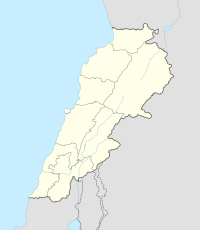Ain Harcha
Ain Harcha
عين حرشة | |
|---|---|
Village | |
 | |
| Country | |
| Governorate | Beqaa Governorate |
| District | Rashaya District |
| Elevation | 3,900 ft (1,200 m) |
| Alternative name | Ain Hircha |
|---|---|
| Location | south of Dahr El Ahmar |
| Region | Bekaa Valley |
| Coordinates | 33°27′23″N 35°47′02″E / 33.456389°N 35.783889°E |
| History | |
| Cultures | Roman |
| Site notes | |
| Condition | Ruins |
| Public access | Yes |
Ain Harcha (or Ain Hircha) is a village situated in the Rashaya District and south of the Beqaa Governorate in Lebanon. It is located east of Mount Hermon close to the Syrian border south of Dahr El Ahmar.[1]
The village sits ca. 1,200 metres (3,900 ft) above sea level and the name is claimed in Aramaic to mean "house of spirits" or "place of worship" with some seeing this as derived from "the feast of sorceries" due to local folklore suggesting an evil spirit of Ain Al-Horsh inhabits the springs of Lebanon.[2]
Roman temple
2 kilometres (2,000 m) (about a forty-minute walk) along a rocky path, on a ridge-top to the west, 525 metres (1,722 ft) higher than the village sits one of the best examples of a Roman temple in the vicinity of Mount Hermon.[3] The temple of Ain Harcha can also be reached by walking down from the village of Ain Ata. It was restored in 1938-1939 and dates from a Greek inscription on one of the blocks to 114-115 AD. The temple is built of limestone, opens to the east and blends in well with the landscape. The pediment and west wall are in particularly good condition and two columns bases show what supported the beams and roof. Carved blocks show busts of Selene, the moon goddess and Helios, the sun god.[4] Around the site are remnants of ancient habitation and tombs.
References
- ^ Anīs Furaiḥa (1972). dictionary of the name of towns and villages in Lebanon. Maktabat Lubnān.
- ^ Qada' (Caza) Rachaya - Promenade Tourist Brochure, published by The Lebanese Ministry of Tourism Archived 13 July 2011 at the Wayback Machine
- ^ Robert Boulanger (1955). Lebanon, p. 205. Hachette.
- ^ George Taylor (1969). The Roman temples of Lebanon: a pictorial guide, p. 30, 75, 105. Argonaut.


